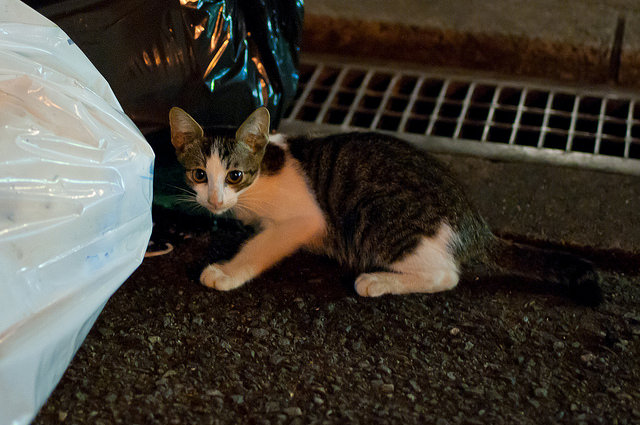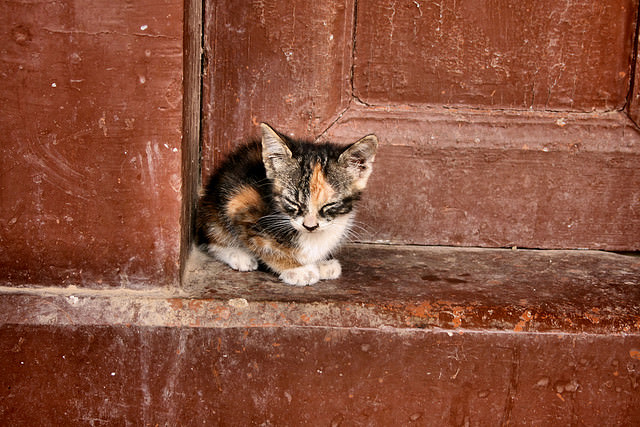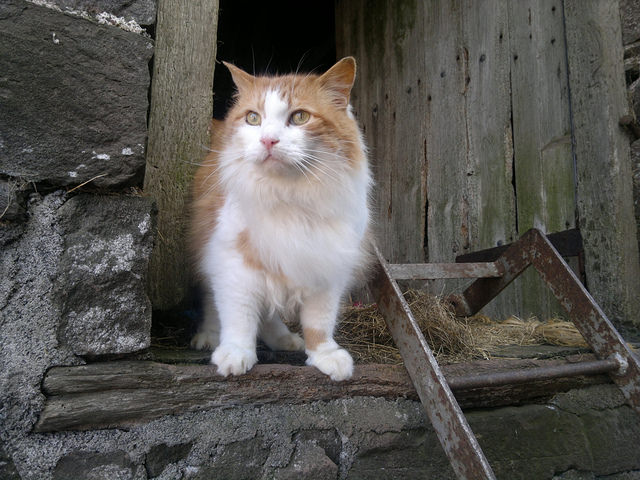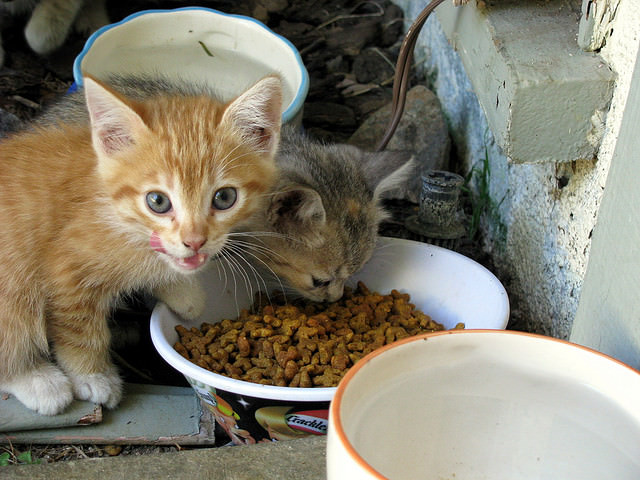
There has been a lot of discussion lately about the most effective and humane way to deal with all our stray cats.
But, according to the Humane Society of The United States (HSUS), “there’s one method that’s shown positive results: TNR (trap-neuter-return). Cats are humanely trapped and if healthy, spay/neutered, rabies vaccinated, ear-tipped for identification and returned to their community. Evidence proves that this method stabilizes cat numbers that eventually dwindle to zero as the cats naturally pass away. “
Nancy Peterson, cat program manager for the HSUS took time to answer our questions about how to humanely manager cat populations.
I read another article that talked about how creating “cat colonies” can actually make the problem worse, by encourage stray cats to stick around, do you agree or disagree?
NP: Trap/neuter/return (TNR) and other sterilization programs are a humane response to the presence of cats in an area. These programs do not put cats where they were not found in the first place. Community (feral and stray) cats tend to naturally congregate in groups, known as colonies, around a common food source. They are typically drawn to an area and will establish themselves where there is food to support them. The food may be provided indirectly, for example, if the cats get into dumpsters, garbage bags and cans, or prey on rodents. When caring people see hungry cats, they often start to feed them. Even if people don’t feed the cats but food sources are available, the cats will likely stick around.
Managing colonies through TNR acknowledges that the cats are already living there, but strives to make their lives better and to curb the population through sterilization.
How fast would TNR reduce to number of cats to zero? Where do these cats come from?
NP: Community (feral and stray) cats are the offspring of unsterilized pet cats who are allowed to roam outdoors, stray cats (friendly cats with no known owner) and feral cats (unsocialized cats with no known owner who are too afraid of people to be adopted into a home).

The number of community cats who live in a specific area, for example, raiding a dumpster behind a restaurant, will depend on how much food is available. This is commonly referred to as “carrying capacity”. If there’s enough food to support 10 cats, that’s how many cats will survive there. If kittens are born, they are unlikely to survive to adulthood, unless the food supply increases. Cats will also defend their territory against new cats attempting to come in and make use of the food source.
Trap and remove has been used for decades and has not reduced the number of community cats. Unless it’s performed with very high levels of resources and manpower and addresses over 50% of a targeted population on an ongoing basis, it doesn’t offset the root of the problem: continued reproduction of un-trapped unsterilized cats. Even if all the cats are removed from a colony, if the food source remains, cats will migrate in from surrounding areas, or other local colonies will have increased kitten survival since there is now more food to go around.
Why is TNR more effective?
NP: Trap and remove is not effective. It has been used for decades and has not reduced the number of community cats. People who care about the cats and know their habits will resist attempts to starve the cats or trap the cats if they’re going to be removed and killed. Also, if trappers don’t know how many cats there are to trap, it’s very likely that some cats will evade trapping. The cats left behind will continue to reproduce and if the food source has remained the same, for example, the restaurant still leaves the dumpster uncovered, the population will grow until it reaches the numbers that the dumpster can support. Of course, the dumpster may not be the only food source for the cats, which makes it even more difficult for trap and remove to be effective.
Even if all the cats could be removed, but the food source or sources remain, new cats will move in to the territory to take advantage of the food supply. They will reproduce and the cycle will begin again. Trap and remove is a non-ending proposition and only leads to newer faces, not fewer cats.
Trap-Neuter-Return (TNR) is an effective strategy for reducing the number of community cats over time. TNR should be considered a humane means to an end, not a method of permanently maintaining community cat populations.
Many groups that do TNR remove kittens young enough to be socialized (less than 8 weeks) and friendly strays for adoption into homes, depending on the resources they have available. Removing kittens and strays results in an immediate reduction in the number of cats.
Someone has to take care of them while they are still alive. Is this more cost effective than disposing of them all at once?
The majority of Americans are opposed to killing community cats for population control. Municipal and private animal shelters also want to stop the killing of healthy cats, regardless of whether they have the resources to do so.
There is a cost to municipalities to remove community cats. They have to send personnel to set the trap and retrieve the trap, the cat has to be transported to the shelter, cared for if there is a mandatory hold period (to allow owners to find their lost cats). Some shelters have found that having their own TNR program is less expensive than repeated cycles of trap and kill.
A recently published study shows that adoption and targeted TNR (matching a target population to available resources in order to achieve a high sterilization rate, which is necessary to achieve population stabilization and reduction) resulted in a 66% reduction in shelter cat impoundment over 2 years.
TNR is typically done by nonprofit organizations and individuals at no cost to municipal agencies. The sheer number of cats who would need to be trapped by municipal agencies far outstrips their ability to do so at the level necessary to result in a sustained reduction in the cat population.
You mentioned rabies, what about other diseases and vaccines?
Sterilized cats are typically healthier overall and have greater immunity against a host of other diseases and parasites. The rates of feline leukemia virus (FeLV) and feline immunodeficiency virus (FIV) in community cats are similar to infection rates reported for owned cats. Sterilized cats are also less likely to transmit these diseases, which are largely spread through mating behavior and mating-related fighting.
Data from clinics that sterilized more than 100,000 community cats nationwide revealed that community cats are generally fit and healthy, with less than one percent requiring euthanasia to end suffering.

What about catching and adopting the cats out? Do you agree or disagree with this practice?
Whereas kittens are the most vulnerable, those young enough (less than 8 weeks) to be socialized (tamed) should ideally be adopted into homes. Stray cats may also be suitable for adoption into homes; however, the resources to do so may not always be available. However, if adoption is not available for a healthy cat and the only option is euthanasia because an agency has too many cats, not enough cage space, not enough money, not enough foster homes – then returning the cat to his environment should be considered.
There is a rescue near me that turns these kitties into “barn cats” and actually adopts them out for free to farmers who need barn kitties for mice control. Do you think programs like this are good or bad? Why or why not?

Barn cat programs are a win for everyone. A cat is spayed or neutered, vaccinated against rabies (and possibly other diseases depending on the program), eartipped (to identify them as sterilized) and brought to a farm, barn, stable, greenhouse, etc. where they are properly introduced to their new home and caretaker. The owners of these locations appreciate that the mere scent of cats will keep rodents, who may destroy grains, transmit diseases, etc., away. Barn programs are becoming more and more popular as animal shelters and humane societies look for life-saving options for community cats.
What are the best ways people can help lower the risk of having a stray cat colony form or grow? Are there preventive things a neighborhood can do?
People who feed or see community cats should try to locate a local animal shelter or humane society, rescue or TNR group, spay/neuter clinic, or a private veterinarian to sterilize as close to 100% of the cats as soon as possible to prevent continued reproduction. Our online map at humanesociety.org/outdoorcats lists these. If there’s no local help available, individuals can read the Neighborhood Cats TNR Handbook to get the skills and confidence to do TNR.
In addition to managing community cats through sterilization programs such as TNR, it is important to that owners: spay and neuter pet cats before they can reproduce at 5 months of age; keep pet cats indoors, safely confined to their property, or walked on a harness and leash; and provide visible identification, so if pet cats go missing they can be reunited with their owners. These actions will help stem the tide of community cat overpopulation at its source.

We also recommend that people think about food sources that they are putting out intentionally or unintentionally, as these may draw cats or wild animals. People using TNR to manage a colony should make sure to reduce food availability as the population of the colony dwindles. We have a number of proper feeding tips available here.
Why can’t community cats be relocated or put in sanctuaries?
Some individuals or municipal agencies may think these are humane alternatives to lethal control, but it’s unrealistic due to the sheer numbers of cats in communities.
Relocation is time-consuming and usually unsuccessful because cats are strongly bonded to their territories.
Sanctuaries might be available in some areas, but those that provide quality care for animals fill up quickly. In addition, it’s an expensive proposition to care for cats in a sanctuary for the rest of their lives and programs such as these need sustainable funding.
How can I persuade municipal leaders to consider TNR?
Our publication, “Managing Community Cats: A Guide for Municipal Leaders,” is available for purchase in print form or can be downloaded for free. It’s a great resource that cat advocates can provide to their municipal officials to help them understand that TNR is the most effective way to reduce community cat populations.
About the Author
Based in Wilsonville, Ore., animal lover Kristina N. Lotz is a Certified Professional Dog Trainer – Knowledge Assessed (CPDT-KA) and a member of the Dog Writers Association of America. She is also the founder of A Fairytail House. In her spare time, she trains and competes in a variety of performance events with her Shetland Sheepdogs and caters to her two rescue kitties. She smartly married a Veterinary Technician, who helps keep the fur kids happy and healthy, and provides a quick resource for articles.
